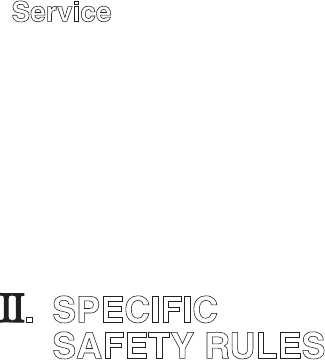
-
3
-
13) Do not force tool. Use the correct
tool for your application.
The correct tool will do the job bet-
ter and safer at the rate for which it
is designed.
14) Do not use tool if switch does
not turn it on or off.
A tool that cannot be controlled
with the switch is dangerous and
must be repaired.
15)
Disconnect battery pack from tool
or place the switch in the locked
or off position before making any
adjustments, changing accessories,
or storing the tool.
Such preventive safety measures
reduce the risk of starting the tool
accidentally.
16)
Store idle tools out of reach of chil-
dren and other untrained persons.
Tools are dangerous in the hands
of untrained users.
17) When battery pack is not in use,
keep it away from other metal
objects like: paper clips, coins,
keys, nails, screws, or other
small metal objects that can
make a connection from one
terminal to another.
Shorting the battery terminals
together may cause sparks, burns
or a fire.
18) Maintain tools with care. Keep
cutting tools sharp and clean.
Properly maintained tools with
sharp cutting edge are less likely to
bind and are easier to control.
19)
Check for misalignment or binding
of moving parts, breakage of parts,
and any other condition that may
affect the tool’s operations. If
damaged, have the tool serviced
before using.
Many accidents are caused by
poorly maintained tools.
20) Use only accessories that are
recommended by the manufac-
turer for your model.
Accessories that may be suitable for
one tool may create a risk of injury
when used on another tool.
Service
21) Tool service must be performed
only by qualified repair personnel.
Service or maintenance performed
by unqualified personnel may
result in a risk of injury.
22) When servicing a tool, use only
identical replacement parts. Follow
instructions in the Maintenance
section of this manual.
Use of unauthorized parts or failure
to follow Maintenance Instructions
may create a risk of shock or injury.
. SPECIFIC
SAFETY RULES
1) Hold tool by insulated gripping
surfaces when performing an
operation where the cutting tool
may contact hidden wiring.
Contact with a "live" wire will make
exposed metal parts of the tool
“live” and shock the operator.
2) Wear ear protectors when using
the tool for extended periods.
Prolonged exposure to high inten-
sity noise can cause hearing loss.
3) Be aware that this tool is always
in an operating condition, it does
not have to be plugged into an elec-
trical outlet.
4) Do not operate the Forward/
Reverse lever when the Variable
speed control trigger is on.
The battery will discharge rapidly
and damage to the unit may occur.
5) If the bit becomes jammed, immedi-
ately turn the Variable speed con-
trol trigger off to prevent an over-
load which can damage the bat-
tery pack or motor. Use reverse
motion to loosen jammed bits.
6) When storing or carrying the tool,
set the Forward/Reverse lever to
the center (switch lock) position.
7) Do not strain the tool by holding
the speed control trigger halfway
(speed control mode) so that the
motor stops.














